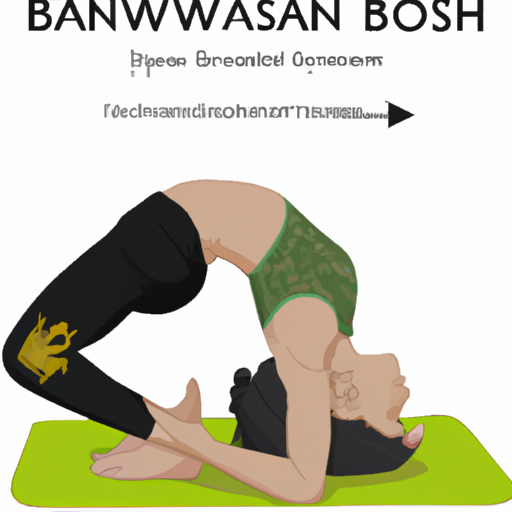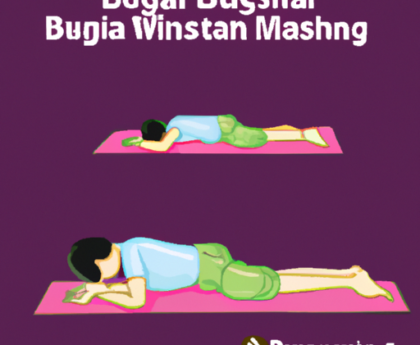“Unlock Your Inner Strength with Dhanurasana – Bow Pose!”
Introduction
Dhanurasana, or Bow Pose, is a powerful backbend that is a great way to open up the chest and shoulders, strengthen the back muscles, and improve posture. It is a great pose for those looking to increase flexibility and strength in the back and core. This pose can be challenging for beginners, but with proper instruction and practice, it can be a great addition to any yoga practice. In this article, we will discuss the steps for doing Dhanurasana, as well as the benefits and modifications for this pose.
How to Prepare for Dhanurasana (Bow Pose): Tips for Beginners
Dhanurasana, or Bow Pose, is an intermediate-level yoga pose that requires strength and flexibility. It is a great pose for strengthening the back and abdominal muscles, as well as improving posture. If you are a beginner, it is important to take the time to properly prepare for this pose. Here are some tips to help you get started.
1. Warm Up: Before attempting Dhanurasana, it is important to warm up your body. Start with some gentle stretches and twists to loosen your muscles and increase your range of motion.
2. Strengthen Your Core: To prepare for Dhanurasana, it is important to strengthen your core muscles. Try some basic core exercises such as planks, crunches, and bridges.
3. Practice Ustrasana: Ustrasana, or Camel Pose, is a great pose to practice before attempting Dhanurasana. This pose will help you to open your chest and shoulders, as well as strengthen your back muscles.
4. Practice Bhujangasana: Bhujangasana, or Cobra Pose, is another great pose to practice before attempting Dhanurasana. This pose will help to open your chest and shoulders, as well as strengthen your back muscles.
5. Practice Dhanurasana: Once you have warmed up and strengthened your core, you can begin to practice Dhanurasana. Start by lying on your stomach and slowly arching your back. Reach your arms back and grab your ankles. Hold the pose for a few breaths before releasing.
By following these tips, you can properly prepare for Dhanurasana and ensure that you are able to safely and effectively practice this pose. With regular practice, you will be able to reap the many benefits of this pose.
Benefits of Practicing Dhanurasana (Bow Pose)
Dhanurasana, or Bow Pose, is a beneficial yoga pose that can help to improve physical and mental health. This pose is a backbend that stretches the entire front of the body, including the chest, abdomen, and hip flexors. It also strengthens the back muscles and helps to improve posture.
Physically, Dhanurasana can help to improve digestion and reduce constipation. It can also help to reduce stress and fatigue, as well as improve circulation. Additionally, this pose can help to improve flexibility in the spine and hips, and can even help to reduce back pain.
Mentally, Dhanurasana can help to reduce anxiety and depression. It can also help to improve concentration and focus, as well as increase energy levels. Additionally, this pose can help to improve self-confidence and self-esteem.
Overall, Dhanurasana is a beneficial yoga pose that can help to improve physical and mental health. It can help to reduce stress and fatigue, improve digestion, and reduce back pain. Additionally, it can help to reduce anxiety and depression, as well as improve concentration and focus. For these reasons, it is important to practice Dhanurasana regularly in order to reap its many benefits.
Modifications and Variations of Dhanurasana (Bow Pose)
Dhanurasana, or Bow Pose, is a classic yoga pose that is beneficial for the entire body. It is a backbend that stretches the entire front of the body, including the chest, abdomen, and hip flexors. It also strengthens the back muscles and helps to improve posture.
There are several modifications and variations of Dhanurasana that can be used to make the pose more accessible to different levels of practitioners.
For beginners, it is recommended to start with a supported version of the pose. This can be done by placing a bolster or blanket under the abdomen for support. This will help to reduce the intensity of the backbend and make it easier to hold the pose for longer periods of time.
For those looking to deepen the pose, there are several variations that can be used. One variation is to clasp the hands behind the back and lift the chest higher. This will increase the intensity of the backbend and help to open the chest and shoulders.
Another variation is to lift the feet off the ground and hold the pose with the arms and legs extended. This will increase the intensity of the pose and help to strengthen the back muscles.
Finally, for those looking to add a challenge to the pose, it is possible to add a bind. This can be done by clasping the hands behind the back and then reaching the arms around the back to clasp the opposite elbow. This will add an extra level of intensity to the pose and help to open the chest and shoulders even further.
No matter which variation or modification of Dhanurasana is used, it is important to practice with caution and listen to the body. It is also important to warm up the body before attempting the pose and to come out of the pose slowly and mindfully.
Common Mistakes to Avoid When Doing Dhanurasana (Bow Pose)
1. Not Warming Up: Before attempting Dhanurasana, it is important to warm up the body with some light stretching and breathing exercises. This will help to prepare the body for the pose and reduce the risk of injury.
2. Not Engaging the Core: It is important to engage the core muscles when doing Dhanurasana. This will help to support the spine and ensure that the pose is done correctly.
3. Not Keeping the Neck Relaxed: It is important to keep the neck relaxed when doing Dhanurasana. Tensing the neck can cause strain and discomfort.
4. Not Breathing Properly: Proper breathing is essential when doing Dhanurasana. It is important to take slow, deep breaths and to focus on the breath throughout the pose.
5. Not Keeping the Knees Together: It is important to keep the knees together when doing Dhanurasana. This will help to ensure that the pose is done correctly and will help to prevent injury.
6. Not Keeping the Feet Flexed: It is important to keep the feet flexed when doing Dhanurasana. This will help to ensure that the pose is done correctly and will help to prevent injury.
7. Not Keeping the Arms Straight: It is important to keep the arms straight when doing Dhanurasana. This will help to ensure that the pose is done correctly and will help to prevent injury.
8. Not Keeping the Shoulders Down: It is important to keep the shoulders down when doing Dhanurasana. This will help to ensure that the pose is done correctly and will help to prevent injury.
9. Not Keeping the Chest Open: It is important to keep the chest open when doing Dhanurasana. This will help to ensure that the pose is done correctly and will help to prevent injury.
10. Not Listening to the Body: It is important to listen to the body when doing Dhanurasana. If any pain or discomfort is felt, it is important to stop and adjust the pose accordingly.
How to Incorporate Dhanurasana (Bow Pose) into Your Yoga Practice
Dhanurasana, or Bow Pose, is an important posture in many yoga practices. It is a backbend that strengthens the spine and opens the chest, shoulders, and hips. It also helps to improve digestion and reduce stress.
To begin, lie on your stomach with your arms at your sides. Bend your knees and reach back to grab your ankles. As you inhale, lift your chest and thighs off the ground, using your arms and legs to create a bow shape. Keep your neck long and your gaze forward.
Hold the pose for five to ten breaths, focusing on your breath and the sensations in your body. To come out of the pose, slowly release your ankles and lower your chest and thighs to the ground.
Dhanurasana can be incorporated into your yoga practice in a variety of ways. You can use it as a warm-up to open the spine and prepare for other backbends. You can also use it as a counterpose after a forward bend or inversion. Finally, you can use it as a peak pose in a sequence, holding it for longer and deepening the backbend.
No matter how you choose to incorporate Dhanurasana into your practice, it is important to listen to your body and practice with awareness. If you experience any pain or discomfort, come out of the pose and rest. With regular practice, you will be able to deepen your backbend and reap the many benefits of this powerful posture.
How to Use Props to Enhance Your Dhanurasana (Bow Pose) Practice
Dhanurasana, or Bow Pose, is an energizing and invigorating backbend that can be a great addition to any yoga practice. Props can be used to enhance your practice of this pose, making it more accessible and comfortable. Here are some tips on how to use props to enhance your Dhanurasana practice.
First, use a yoga block or bolster to support your chest and abdomen. Place the block or bolster lengthwise on the mat and lie down on it so that your chest and abdomen are supported. This will help you to open your chest and abdomen more easily and comfortably.
Second, use a strap to help you reach your feet. Place the strap around the soles of your feet and hold onto the ends of the strap with your hands. This will help you to keep your feet together and your legs straight as you lift your chest and abdomen off the floor.
Third, use a blanket to support your lower back. Place the blanket lengthwise on the mat and lie down on it so that your lower back is supported. This will help to protect your lower back from strain and discomfort.
Finally, use a wall to help you maintain the pose. Stand facing the wall and place your hands on the wall at shoulder height. Then, slowly walk your feet away from the wall until your body forms a bow shape. This will help you to maintain the pose for longer and to deepen the backbend.
By using props to enhance your Dhanurasana practice, you can make the pose more accessible and comfortable. With the right props and proper alignment, you can enjoy the benefits of this energizing and invigorating backbend.
Conclusion
Dhanurasana is a great pose for strengthening the back and core muscles, as well as improving flexibility in the spine and hips. It can be challenging to master, but with practice and patience, you can learn to do it correctly and reap the benefits of this powerful pose. Remember to always listen to your body and take breaks when needed. With regular practice, you can enjoy the many benefits of Dhanurasana.




